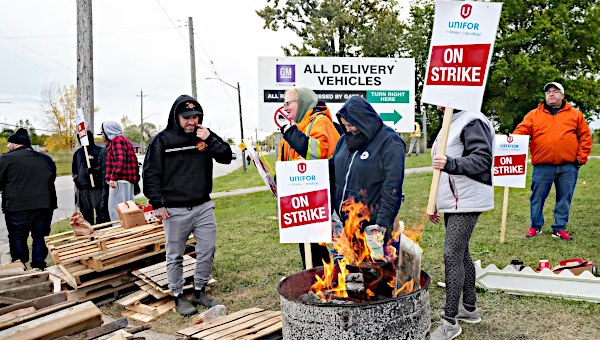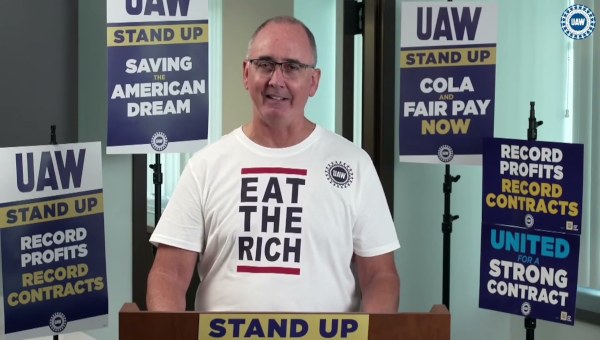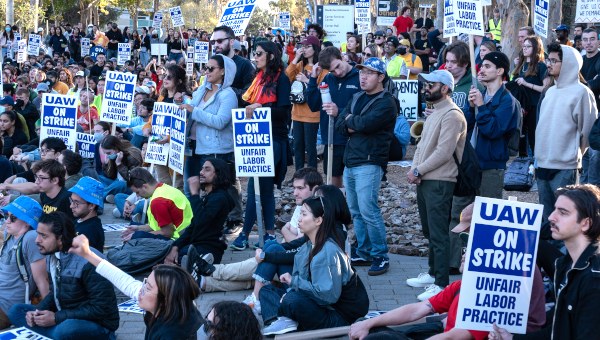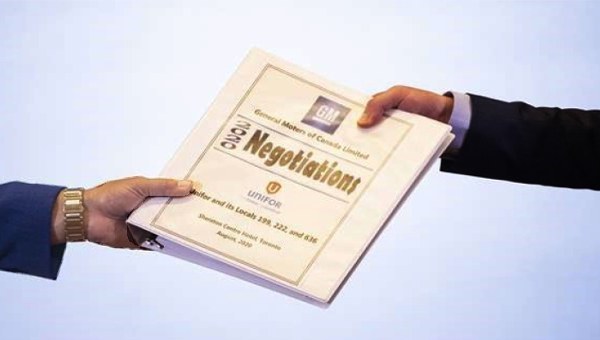The UAW-Big Three Settlements: From Defeat to Rebellion
The 2007 United Autoworkers (UAW) agreements with the Detroit Big Three represented – as many people inside and outside the union have noted – the greatest economic concessions in the history of the union. Yet, in the course of that defeat, a remarkable opposition arose. It was led by a small group of activists who started late in the day and with limited organizational resources. At General Motors (GM), a third of those who cast their ballots voted against the agreement and at Chrysler the vote against the agreement was quite general at the large plants outside of Detroit. The question now is whether that oppositional base can be built on and what its first focus might be.
Concessions and Competitiveness
There is good reason for U.S. workers to be sceptical about the argument that concessions save jobs. At GM, there were some 450,000 UAW workers at the end of the 1970s when the concessions began. In every subsequent agreement, concessions were sold as a trade-off for ‘job guarantees.’ Yet, when 2007 bargaining began, GM had all of 73,000 UAW members – more than 4 of 5 jobs were gone.
These job losses had many explanations, but not working hard enough or blocking productivity were not among them. Output per worker doubled in assembly between 1987 and 2005 and output per worker in the parts sector was only slightly behind, increasing by 85%). And worker compensation, even with the higher health care costs, didn’t even match that productivity growth.
[See U.S. BLS].
Workers might be angry after losing their jobs in spite of working hard and being blackmailed into concessions. But the outcome shouldn’t surprise us. To some extent, the corporations couldn’t really guarantee jobs even if they wanted to. To have a crack at protecting jobs, we’d have to move beyond the false promises of corporations and address free trade and the sanctity of corporate property rights. Moreover, reducing jobs was actually part of the competitive strategy of the corporations. So any move to some real job protection would have meant taking on the corporations and broader political battles; it wasn’t going to be handed to workers when they were weak and making concessions.
And that gets us to the key issue: the problem with concession-bargaining is not just the surrender of past gains with no improvement in security, but that in the process of buying into that logic, workers are weakened for subsequent struggles. And then, when concessions come up in the future, workers feel – in spite of their experiences – that giving in is even more inevitable than it was before.
The New Hire Rate
There are few more obvious examples of this undermining of workers’ potential strength than the New Hire Rate in the latest UAW agreements. The workforce is divided into ‘core’ (roughly assembly-line jobs) and ‘non-core’ (e.g. sub-assembly, machining, material handling, truck drivers, and – where they are still in the bargaining unit – janitors). The non-core jobs are estimated to run anywhere from 25%-40% of the workforce, depending on how much outsourcing has already been done. New hires brought into the non-core jobs will receive about half of the current wage rates and their benefits will be cut even more; new hires won’t even be in the eroded VEBA (Voluntary Employees Beneficiary Association) structure for retiree health care, and they will be excluded from the Big Three defined benefit plans. According to GM, this will cut the overall costs of a GM new hire to about one-third that of existing workers (Ward’s Automotive, October 22, 2007).
This is bad enough in itself, but if the company could get away with this, it might even push further. At Ford, there is already a new twist on this; Ford is allowed to have 20% of the workforce at the reduced new hire rate, even if they are in core jobs. [For more on the new hire rate, see: futureoftheunion.com
and soldiersofsolidarity.com].
How can workers possibly build the unity for future battles when the union has just implemented structures guaranteed to divide the workers? How can unions develop a new generation of activists – crucial to reviving the movement – when the first thing the new workers learn is that the union has made them into second-class members?
Yet, isn’t it true that health care costs were undermining the Big Three relative to Toyota and Honda? And weren’t Big Three wages far higher than their competitors? Did UAW members really have a choice?
The New Hire Rate and Competitiveness
The irony of the new agreements is that even in terms of the logic of competitiveness, the New Hire Rate will not achieve anything for workers. In the case of health care costs, there was in fact a real problem for the Big Three, and it did have to be addressed or Toyota and Honda (as well as others) would have steadily eroded the Big Three’s market. As the opposition, however, insisted, the problem lay in how the union responded. Rather than leading a struggle for a universal national program which benefited all working people, the UAW leadership accepted shifting the costs and risks to its members – reinforcing the inegalitarian and shameful U.S. health care system.
The New Hire Rate, on the other hand, doesn’t have the same effect as the shift in health costs. The wages at the transplants are set to avoid unionization and more or less track the Big Three. Wage cuts at the Big Three will, therefore, simply give the Japanese companies the room to follow suit. Wages (and benefits) will fall across companies, but the economic relationship between the Big Three and the transplants will not change.
Wall Street gets it. It sees the new hire rate as the ‘sleeper’ in the agreement. Wall Street smells blood because, as suggested above, they sense it won’t stop there. They know it’s not about jobs: Big Three stocks go up whenever they cut jobs. It is about continuing to erase jobs and use the consequent insecurity to make further gains and spread concessions.
We need to be as clear as the Big Three and Wall Street are. What’s going on here is lower wages for Big Three workers and at the transplants. What is being set up here is higher profit for each of the auto companies at the expense of workers. What won’t ultimately change are the relative costs between the Big Three and the transplants. Even in terms of the logic of ‘competitiveness,’ the New Hire Rate won’t leave autoworkers in any better position as far as job security is concerned.
Competition from Abroad
It’s important to note that when it comes to manufacturing, the U.S. has essentially become a low-cost producer within the developed world. And yet pressures continue to push wages and benefits lower.
Since the previous collective agreement (September, 2003), the U.S. dollar has fallen by some 30% relative to the Euro, the British Pound, and the Canadian dollar. Among the G-7 countries (the leading developed capitalist countries), hourly compensation in U.S. manufacturing is now about 40% below that in Germany, 20% below that of Canada, Britain and France, and slightly below that of Italy. The only one of the G-7 with manufacturing labour costs below the U.S. is Japan: that difference is only about 7% and may also change as the Japanese Yen rises relative to the U.S. dollar.
At a time when the dollar is falling so rapidly and further lowering U.S. costs relative to other countries, there is something rather bizarre to hear anyone use ‘international competitiveness’ to justify further concessions.
In auto and parts the situation is slightly different. U.S. overall labour costs are somewhere in the middle of the G-7: U.S. costs (leaving aside the latest concessions) are at about 2/3 the level of Germany, slightly below Canada, roughly at par with the UK, above France and Italy and almost 30% above Japan. [The data is derived from the U.S. Bureau of Labor. The latest data is from 2004-5 and updated here by adjusting for shifts in exchange rates since then. For the base data,
see: ftp://ftp.bls.gov/pub/special.requests/ForeignLabor/industrynaics.txt.]
Three points about that gap with Japan are crucial:
- Japan went through a major economic crisis through the 90s and into the present decade; though U.S. labour costs in auto haven’t been rising especially fast, Japanese labour costs between 1992 and the present have grown at half that rate.
- The Japanese Yen has been unique among major currencies in that it has barely risen against the dollar. In this context, it hardly makes sense to argue that workers coming into the auto industry should be made into second class workers because of the exchange rate policy of the government of Japan.
- Projections on auto capacity through 2011 show it growing slightly in the U.S. while Japan’s capacity is expected to actually fall slightly (for South Korea as well). The reason is that Japanese companies are replacing their exports with production abroad – including coming to the U.S. (Price Waterhouse Coopers, ‘Global Assembly Shifts into Drive’, November 9, 2007).
The crucial point is that the competitive threat to the Big Three is in fact not from abroad,
but from non-unionized plants within the USA: plants that should be unionized. And this gets us back
to the argument that the New Hire Rate doesn’t change relative wages but only lowers
them for all workers in the U.S. auto sector.
Ironically, there is now a new argument to convince Toyota and Honda to join the union. The UAW used to argue that workers should join the union so they could be brought up to our standards. Now, the argument is becoming that if they don’t want to be dragged down by us, they will have to join with us to protect even their current rates.
Concessions and Bringing Parts Work Back to the Big Three
It is a rather stunning argument for any trade unionists to make about bringing parts work back to the Big Three through concessions. The whole point of industrial unionism was to take labour costs out of the competition between companies. This was the fundamental key to raising wages and other standards. To suggest that lowering Big Three wages is a way to take jobs from the parts sector – rather than bringing wages in the parts sector up to improve standards in that sector and protect those in the Big Three – is a reflection of how far the UAW leadership has gone in forgetting the union’s roots. And it is simply not credible. Every parts worker knows that if the Big Three are cutting wages, parts workers will face even greater pressures to do the same, and no workers win.
Time to Rebel?
There is something that can be done and it can be done immediately. UAW members should be organizing themselves to demand, in the next round of negotiations, that new hires will be brought up to standard wages over the same limited period as before the 2007 agreement. This is doable. It only requires a wage increase for those hired during the life of this agreement and a return to the traditional new hire rates for those hired after this agreement.
This campaign can be started immediately:
- Committees to end second class union membership should be formed in every Big Three workplace.
- These committees should be linked into a communication network to share mobilizing progress, sharpen arguments, organize regional forums, and develop the necessary tactics for the 2011 bargaining round.
- The argument to be made is straightforward and it should be especially effective in reaching new members and bringing them into a culture of resistance as opposed to one of resignation.
What about Canadian Auto Workers and the CAW?
The Canadian Auto Workers (CAW) have come out strongly against the new-hire rate and this recalls the early 80s. Earlier, the UAW accepted the concessions trend and the Canadians, in the course of challenging that trend, went so far as to leave the UAW and set up a new union.
This time, however, the Canadians are in quite a different position: the dollar is not 20-25% below the U.S. but at par, and Canadian nominal wages and time off are higher. As well, in that earlier period the union was full of confidence. It was coming off a decade of militancy, leading the one-day general strike in 1976 against wage controls, encouraging a host of plant takeovers through the late 70s and early 80s, and had already taken on concessions in the parts industry through an eight-month strike at a unit of Rockwell. Today, however, many see the CAW as floundering in bargaining, organizing and politics.
Nevertheless, CAW President Buzz Hargrove has come out strongly against allowing the New Hire Rate into Canada.
[See CawLocal200.org – ‘Buzz Hargrove Speech’]. This is clearly welcome and important. But can the Canadians really reject this if the Americans have accepted it?
In the longer term, continuing to reject the New Hire Rate without the Americans also doing the same may not be sustainable. But in the next agreement – coming up in September, 2008 – a rejection is absolutely crucial. If the Canadians accept the New Hire Rate in any form, this will further entrench it and make it more difficult for the UAW opposition to reverse it. But if the Canadians reject it for the next three years, this can strengthen and inspire resistance in the UAW when they are in bargaining again in 2011 (CAW agreements will also be up in 2011).
Though the corporations will make their threats, any uncertainty about whether the New Hire Rate will remain in place after 2011 means they will not make long-term decision on the basis of what happens in Canadian bargaining in 2008. When the Canadian split from the Americans, the companies also made threats but then waited to see how things would unfold and investment in Canada actually increased dramatically. For the Canadians, therefore, there is a critical opportunity to lead the North American industry in rejecting a step that the UAW leadership should never have made.
Conclusion
The extent of the American working class acceptance of the burden for any emerging crisis in the economy has been critical to keeping the American empire going, and to weakening working class standards in the rest of the world. The economic and political ‘flexibility’ of U.S. labour matters to all of us.
It is important to keep the New Hire Rate in perspective. If American autoworkers can win this fight, they will only be back to where they were before the 2007 round of bargaining and that was hardly a utopia. But a rare victory, particularly one that witnessed some self-organizing from below, could be an exciting turning point and a step towards raising other, more complex questions about class, democracy and social change in the United States. •
For more information on UAW negotiations:
• futureoftheunion.com
• soldiersofsolidarity.com
• SPARK: The Course of the Fight against the 2007 Contracts





